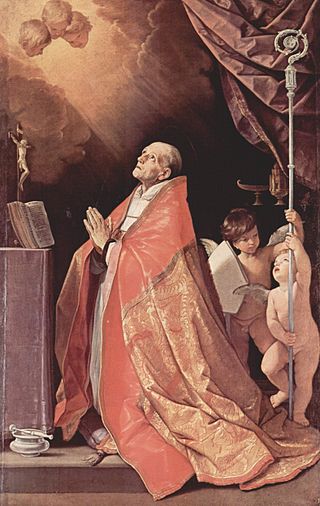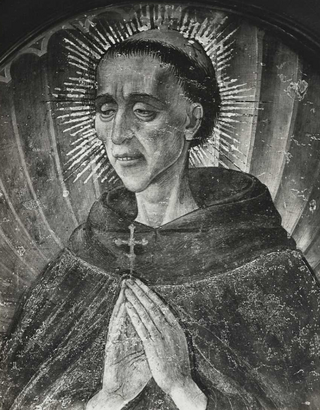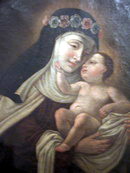
Andrea Corsini was an Italian Catholic prelate and professed member from the Carmelites who served as the Bishop of Fiesole from 1349 until his death.

Nicolás Factor was a Spanish Roman Catholic priest and a professed member from the Order of Friars Minor as well as a painter of the Renaissance period. Factor served as an apt preacher across his region - despite wanting to be sent to the foreign missions - and was noted for his practices of self-mortification before he gave sermons.

Sebastian Maggi (1414–1496) was an Italian Roman Catholic priest and a professed member of the Dominicans. Maggi also served as the confessor to both Girolamo Savonarola and Catherine of Genoa.

Angelo Agostini Mazzinghi, O.Carm was an Italian Catholic priest and Carmelite friar. He was a noted preacher from Florence and was known for his pious devotion to the Carmelite Rule and to the spread of the gospel.

Jakub Strzemię was a Polish Roman Catholic archbishop and a professed member of the Order of Friars Minor. He served as the Archbishop of Halicz from 1392 until his death when the archdiocese was incorporated into that of the Archdiocese of Lviv.

Blessed Ladislas of Gielniów was a Polish Roman Catholic priest and a professed member of the Order of Friars Minor. He was an observant of the Rule of Saint Francis of Assisi and served his order in various capacities that included both a doorkeeper and as its provincial. He also travelled across Poland to evangelize to the faithful and was a noted preacher.

Robert de Turlande was a French Roman Catholic priest and professed member of the Order of Saint Benedict. He was of noble stock and was also related to Saint Gerald of Aurillac. He is best known for the establishment of the Benedictine convent of La Chaise-Dieu and for his total commitment to the poor.

Andrea Bertoni was an Italian Roman Catholic priest and a professed member of the Servite Order. Bertoni assumed the religious name of "Giacomo Filippo" upon being admitted to the Servites and he became the procurator of the convent he lived in from his appointment until his death.

Baldassare Ravaschieri was an Italian Roman Catholic priest and a professed member of the Order of Friars Minor of the strict observance. Ravaschieri served as a noted preacher and confessor and befriended as contemporaries Blessed Bernardine of Feltre and architect Giovanni Antonio Amadeo.

Bernardo Scammacca, OP was an Italian Catholic priest and member of the Order of Preachers. After leading a dissolute early life, his conversion after a sustaining a wound from a duel led him down the path toward religious life. He became a noted prophet and spent hours in the confessional.

Ugolino da Gualdo Cattaneo was an Italian Roman Catholic professed religious and friar of the Order of Saint Augustine. Ugolino is best known for founding an Augustinian convent in Gualdo Cattaneo in 1258 where he served as its prior until his death. He practiced a rigorous spiritual life with austerities including frequent bouts of strict silence and fasting.

Francesco Lippi was an Italian Roman Catholic professed religious from the Carmelites. He lived his life as a soldier before suffering the loss of sight at which point his healing led him down the path of repentance and into the Carmelites.

Antonio Patrizi was an Italian Roman Catholic priest and a professed member of the Order of Saint Augustine. Patrizi joined the order in Lecceto and lived as a hermit prior to his sudden death while visiting his friend at another convent.
Rinaldo da Concorezzo was an Italian Roman Catholic priest and archbishop who served as the Bishop of Vicenza from 1296 until his 1303 appointment as the Archbishop of Ravenna-Cervia holding that until his death.
Giacomo Benefatti was an Italian Catholic priest and professed member of the Order of Preachers who ascended to the position of Bishop of Mantua. Benefatti became noted for his tender care of the ill during epidemics of plague and both Pope Benedict XI - a close personal friend - and Pope John XXII held him in high esteem.

Benincasa da Montepulciano was an Italian Roman Catholic professed religious from the Servite Order. He lived as a hermit in Siena his entire life since he joined the order as a teenager and dedicated himself to a quiet life of servitude to God in contemplation despite still receiving visitors and orders from his superiors.

Arcangelo Canetoli was an Italian Roman Catholic priest and a canon regular of Santa Maria di Reno. Canetoli escaped the massacre of his parents and brothers who were killed in Bologna during a political feud and embraced the religious life not long after where he became noted to the point he turned down repeated offers to serve as the Archbishop of Bologna and the Archbishop of Florence.

Gregorio Celli was an Italian priest of the Roman Catholic Church and a professed member of the Order of Saint Augustine. Celli lived with the latter order in Rimini until he decided to spend the remainder of his life in deep contemplation and so moved to the region's hills where he dwelled in a cave near the Franciscans stationed there. It is claimed he was expelled from his order and became a Franciscan though there is no evidence to support this claim.

Giovanna Scopelli, O.Carm was an Italian Carmelite nun who established her own convent. Scopelli was forbidden to enter the third order branch of the order during her adolescence and waited until her parents died to embrace the religious life.
Bonaventura Tornielli was an Italian Roman Catholic priest and a professed friar from the Servite Order. Tornielli was born into a noble household and was a noted preacher in which he visited numerous Italian cities such as Florence and Perugia - Pope Sixtus IV held him in high esteem and even named him the "Apostolic Preacher". He also held various positions of leadership within his order.

















